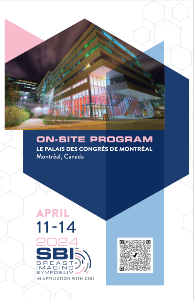Back
Session 3: Management of Nonmalignant Architectural Distortion on Digital Breast Tomosynthesis without an Ultrasound Correlate
Saturday, April 13, 2024
1:30 PM – 2:30 PM
Location: 510B

Derek L. Nguyen, MD
Assistant Professor of Radiology
Duke University Medical Center
Duke University Medical Center
Abstract Presenter(s)
Purpose: The purpose of this study was to determine outcomes of nonmalignant architectural distortion (AD) at biopsy on digital breast tomosynthesis (DBT) without an ultrasound correlate.
Materials and Methods: This retrospective cohort study reviewed 96 cases of DBT detected AD without an ultrasound correlate that had nonmalignant pathology following stereotactic-guided biopsy from our academic institution from 7/1/2020 to 3/30/2023. Our standard operating procedure is to obtain 12 vacuum-assisted 9-gauge core needle biopsy samples via stereotactic guidance for AD. Concordant, benign pathologies underwent a 6-month diagnostic mammogram and if stable, returned to annual screening mammography. Patients lost to follow-up were excluded. Outcome data were summarized using descriptive statistics.
Results: There were 76 patients (mean age 59 years, range: 31-87) with 77 cases of nonmalignant AD. There were 47% (36/77) benign, 38% (29/77) radial scar, and 16% (12/77) atypia: 8% (1/12) flat epithelial atypia (FEA), 33% (4/12) atypical lobular hyperplasia (ALH), and 58% (7/12) atypical ductal hyperplasia (ADH). Of the 36 concordant benign cases, 81% (29/36) underwent 6-month diagnostic follow-up. All were stable at 6 months and no malignancy was identified on the next screening mammogram. The remaining 19% (7/36) benign AD were considered discordant after biopsy and none were upgraded at surgical excision. Of the 29 cases yielding radial scar AD, 55% (16/29) underwent 6-month diagnostic follow-up. All were stable at 6 months and no malignancy was identified on the next screening mammogram. The remaining 45% (13/29) radial scars underwent surgical excision at the patient's request and none were upgraded. The single FEA case underwent mammographic follow-up and was stable at 6-months and 1-year mammograms. Of the four ALH cases, 25% (1/4) elected for mammographic follow-up and were stable at the 6-month and 1-year mammograms. The remaining 75% (3/4) of ALH cases underwent surgical excision and none were upgraded. Of the seven ADH cases, all underwent surgical excision and 43% (3/7) were upgraded at surgical excision. Two cases were upgraded to ductal carcinoma in situ and one case to invasive ductal carcinoma.
Conclusion: Patients with benign, non-atypia architectural distortion detected on DBT without an ultrasound correlate remain cancer free within a year of biopsy. Architectural distortion with atypia has a surgical upgrade rate of 25% due to upstaging of ADH.
Clinical Relevance Statement: It is safe to avoid surgery in patients with benign, non-atypia pathology that presents as architectural distortion on DBT without an ultrasound correlate if 12 vacuum-assisted 9-gauge core samples are taken at stereotactic-guided biopsy.
Materials and Methods: This retrospective cohort study reviewed 96 cases of DBT detected AD without an ultrasound correlate that had nonmalignant pathology following stereotactic-guided biopsy from our academic institution from 7/1/2020 to 3/30/2023. Our standard operating procedure is to obtain 12 vacuum-assisted 9-gauge core needle biopsy samples via stereotactic guidance for AD. Concordant, benign pathologies underwent a 6-month diagnostic mammogram and if stable, returned to annual screening mammography. Patients lost to follow-up were excluded. Outcome data were summarized using descriptive statistics.
Results: There were 76 patients (mean age 59 years, range: 31-87) with 77 cases of nonmalignant AD. There were 47% (36/77) benign, 38% (29/77) radial scar, and 16% (12/77) atypia: 8% (1/12) flat epithelial atypia (FEA), 33% (4/12) atypical lobular hyperplasia (ALH), and 58% (7/12) atypical ductal hyperplasia (ADH). Of the 36 concordant benign cases, 81% (29/36) underwent 6-month diagnostic follow-up. All were stable at 6 months and no malignancy was identified on the next screening mammogram. The remaining 19% (7/36) benign AD were considered discordant after biopsy and none were upgraded at surgical excision. Of the 29 cases yielding radial scar AD, 55% (16/29) underwent 6-month diagnostic follow-up. All were stable at 6 months and no malignancy was identified on the next screening mammogram. The remaining 45% (13/29) radial scars underwent surgical excision at the patient's request and none were upgraded. The single FEA case underwent mammographic follow-up and was stable at 6-months and 1-year mammograms. Of the four ALH cases, 25% (1/4) elected for mammographic follow-up and were stable at the 6-month and 1-year mammograms. The remaining 75% (3/4) of ALH cases underwent surgical excision and none were upgraded. Of the seven ADH cases, all underwent surgical excision and 43% (3/7) were upgraded at surgical excision. Two cases were upgraded to ductal carcinoma in situ and one case to invasive ductal carcinoma.
Conclusion: Patients with benign, non-atypia architectural distortion detected on DBT without an ultrasound correlate remain cancer free within a year of biopsy. Architectural distortion with atypia has a surgical upgrade rate of 25% due to upstaging of ADH.
Clinical Relevance Statement: It is safe to avoid surgery in patients with benign, non-atypia pathology that presents as architectural distortion on DBT without an ultrasound correlate if 12 vacuum-assisted 9-gauge core samples are taken at stereotactic-guided biopsy.

